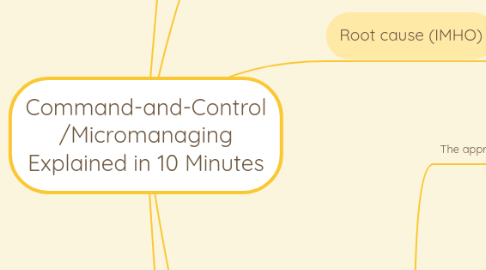
1. Pros
1.1. Actual
1.1.1. Boss feels greater self-importance, autonomy and purpose
1.1.2. Boss earns greater kudos with peers and upper-level managers
1.1.2.1. Boss may be perceived as higher worth to organisation due to clear worth and "irreplaceability"
1.1.2.2. Boss may be more likely to get a raise or promotion
1.1.3. When boss really is the expert in the domain (compared to her/his subordinates capabilities) then a valuable solution is likely to be found quicker when boss makes the decisions
1.1.3.1. This approach can work well when deadlines are tight, immovable and mission-critical
1.1.3.2. It works well when subordinates are newbies and really do need hand-holding
1.2. Perception
1.2.1. Boss believes s/he will save time by being heavily involved
1.2.1.1. in the belief that her/his subordinates won't get it right (i.e., they will mess it up)
1.2.2. Boss believes that there is too much at stake to allow it to go wrong (i.e., his/her credibility is on the line)
1.2.2.1. in the belief that her/his subordinates won't do their job according to her/his standards
1.2.2.2. in the belief that the work won't get done on time unless s/he constantly prods them
1.2.3. Boss believes that s/he is expected to be heavily involved in her/his subordinates' work (by her/his own boss)
1.2.3.1. in the belief that s/he has to prove her/his worth
2. What are some tell-tale signs that someone has this style?
2.1. They resist delegating and make decisions for subordinates
2.1.1. They tell their subordinates exactly how they want things done and leave them no room for them to take initiative
2.2. They ask for frequent updates on where things stand
2.2.1. They ask to be cc’d on emails
2.3. They constantly want to know where their subordinates are and what they’re working on
2.4. They inhibit others from making decisions without consulting them
2.5. They immerse themselves in overseeing the projects of others
2.6. They laser in on the details and start by correcting tiny details instead of looking at the big picture
2.6.1. They often feel frustrated because they would’ve gone about the task differently
2.6.2. They take back delegated work before it is finished if they find a mistake in it
2.6.3. They are never quite satisfied with deliverables
2.6.3.1. They feel that if they want something done right, they have to do it themself
3. Root cause (IMHO)
3.1. Fear of failure
4. Cons
4.1. The approach doesn't scale
4.1.1. Boss has a limited capacity (168 hours in a week) within which one can only micromanage a limited number of subordinates effectively
4.1.1.1. Above that threshold, the quality of decisions will decrease and stress levels will increase
4.1.2. Boss dilutes his/her own productivity, leading to less capacity to get more important things done
4.2. Subordinates become frustrated, demoralised and demotivated
4.2.1. Subordinates stop speaking up
4.2.1.1. i.e., subordinates are less likely to contribute their own creativity to solution and go "the extra mile"
4.2.2. Any value that subordinates could add are less likely to be heard and/or implemented
4.2.2.1. as such subordinates are going to be less engaged (see self-determination theory below)
4.2.2.2. and less productive over the mid- and long-term
4.2.3. They are unlikely to share ownership of the work
4.2.4. They become scared of taking initiative
4.3. Boss more likely to fall into hero syndrome
4.3.1. The hero syndrome is a phenomenon affecting people who seek heroism or recognition, usually by creating a desperate situation which they can resolve https://en.wikipedia.org/wiki/Hero_syndrome
4.4. Boss more likely to resort to ineffective carrot and stick approaches to motivate employees
4.4.1. There have been numerous studies demonstrating that extrinisic motivation strategies (i.e., carrots and sticks) are not nearly as effective as intrinisc motivation ones in knowledge work contexts
4.4.2. Self-determination theory (an intrinisic motivation theory) identifies three innate needs that, if satisfied, allow optimal function and growth https://en.wikipedia.org/wiki/Self-determination_theory
4.4.2.1. Competence
4.4.2.1.1. Seek to control the outcome and experience mastery
4.4.2.2. Relatedness
4.4.2.2.1. Is the universal want to interact, be connected to, and experience caring for others
4.4.2.3. Autonomy
4.4.2.3.1. Is the universal urge to own one's life and act in harmony with one's values
4.4.2.4. see Dan Pink's excellent video https://www.youtube.com/watch?v=u6XAPnuFjJc
4.5. Subordinates eventually engage in “learned helplessness”
4.5.1. where they start believing that the only way they can perform the work is if the boss micromanages them
4.5.2. An organisational vulnerability is created when the subordinates aren’t used to functioning without the boss' presence and heavy involvement
5. In Summary
5.1. The crying shame of this approach is:
5.1.1. Not maximising the knowledge and skills of the people involved
5.1.1.1. The crime is even worse for capable subordinates in a team that have the potential to generate emergent behaviour
5.1.1.1.1. i.e., the sum of the whole is greater than the parts
5.1.2. Not supporting them to be the best that they can be
5.1.2.1. i.e., a lack of Servant Leadership (a possible topic of a future mindmap)
5.1.2.2. It stunts the subordinates’ development and demoralises them
5.2. While micromanaging, one may get short-term results, although over time it negatively impacts the subordinates, organisation, and the 'host'...
5.2.1. Any takers?
